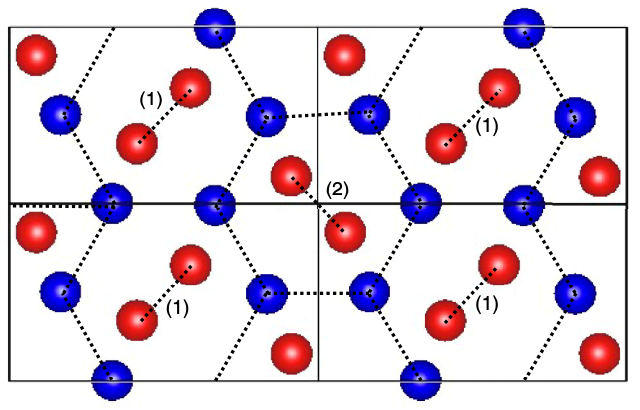Hydrogen, as the first element to form, contains clues on the distribution of matter in the universe.
 A new crystal structure (atomic arrangement pattern) called the P21/c-8 type, which is predicted to be achieved under very high pressure, such as deep inside the Earth. (Image Credit: Ryo Maezono from Japan Advanced Institute of Science and Technology).
A new crystal structure (atomic arrangement pattern) called the P21/c-8 type, which is predicted to be achieved under very high pressure, such as deep inside the Earth. (Image Credit: Ryo Maezono from Japan Advanced Institute of Science and Technology).
Generally a gas, hydrogen occurs as a solid under ultra-high-pressure conditions typically present in the core of massive gaseous planets. However, the structures of solid hydrogen have not been established due to challenges in duplicating such conditions in the lab.
Currently, a new study offers insight into this aspect using simulations and data science approaches. Elements in the periodic table can occur in many forms. Carbon, for example, exists as diamond or graphite according to the environmental circumstances at the time of formation.
Crystal structures that have been developed in ultra-high-pressure environments are especially vital as they offer clues to planet formation.
However, recreating such environments in a lab is tough, and materials scientists frequently depend on simulation predictions to detect the presence of such structures.
Incidentally, hydrogen is particularly significant for examining the distribution of matter in the universe and the behavior of massive gas planets. However, the crystal structures of solid hydrogen developed under high pressure are still under dispute due to the hardship of carrying out experiments involving high-pressure hydrogen.
Furthermore, the structural pattern is directed by a delicate balance of factors including electric forces on the electrons and fluctuations enforced by quantum mechanics, and for hydrogen, the fluctuations are predominantly large, rendering the predictions of its crystal phases even more challenging.
Recently, in a joint study published in Physical Review B, an international team of scientists comprising Professor Ryo Maezono and Associate Professor Kenta Hongo from Japan Advanced Institute of Science and Technology (JAIST) handled this problem using a clever combination of supercomputer simulations and data science, exposing several crystal structures for hydrogen at low temperatures near 0 K and high pressures.
For crystal structures under high pressure, we have been able to generate several candidate patterns using a recent data science method known such as genetic algorithms, etc. But whether these candidates are truly the phases that survive under high pressure can only be determined by high-resolution simulations.
Ryo Maezono, Professor, Japan Advanced Institute of Science and Technology
Accordingly, the researchers studied several possible structures that can be developed with 2 to 70 hydrogen atoms at high pressures (400-600 GPa) using a method known as "particle swarm optimization" and density functional theory (DFT) calculations and projected their relative stability using first-principles quantum Monte Carlo technique and DFT zero-point energy corrections.
The search generated 10 possible crystal structures that were formerly not found by experiments, including nine molecular crystals and one mixed structure, Pbam-8 encompassing atomic and molecular crystal layers occurring alternatively.
However, they learned that all the 10 structures revealed structural dynamic instabilities. To acquire a stable structure, the scientists relaxed Pbam-8 in the direction of instability to develop a new dynamically stable structure called P21/c-8.
The new structure is a promising candidate for the solid hydrogen phase realized under high-pressure conditions such as that found deep within the Earth.
Dr. Kenta Hongo, Associate Professor, Japan Advanced Institute of Science and Technology
The new structure was confirmed to be more stable than Cmca-12, a structure that was formerly found to be a valid option in the H2-PRE phase, one of the six structural phases detected for solid hydrogen at high pressure (360-495 GPa) that is stable at near 0 K. The scientists further confirmed their results by comparing the infrared range of the two structures, which showed a similar pattern normally witnessed in the H2-PRE phase.
The hydrogen crystal problem is one of the most challenging and intractable problems in materials science. Depending on the type of approximation used, the predictions can vary greatly and avoiding approximations is a typical challenge. With our result now verified, we can continue our research on other structure prediction problems, such as that for silicon and magnesium compounds, which have a significant impact on earth and planetary science.
Ryo Maezono, Professor, Japan Advanced Institute of Science and Technology
Based on the study results, more such exciting discoveries could be possible in the future.
Journal Reference:
Ichibha, T., et al. (2021) Candidate structure for the H2-PRE phase of solid hydrogen. Physical Review B. doi.org/10.1103/PhysRevB.104.214111.